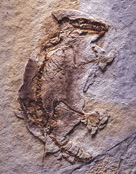
Eomaia scansoria: discovery of oldest known placental mammal
Alec MacAndrew
In Nature 416 816 - 822, Ji et al report a fossil of the earliest known eutherian (placental) mammal (1).
|
|
|||||
| Eomaia scansoria (Chinese Academy of Geological Sciences (CAGS) 01-IG-1a, b; holotype). a, Fur halo preserved around the skeleton (01-IG-1a, many structures not represented on this slab are preserved on the counter-part 01-IG-1b, not illustrated). b, Identification of major skeletal structures of Eomaia. c, Reconstruction of Eomaia as an agile animal, capable of climbing on uneven substrates and branch walking. Taken from ref (1) | |||||
This fossil was found in Lower Cretaceous
Yixian formation. It is extremely well preserved, and both part and
counter-part were recovered. It is a complete cranial and post-cranial
skeleton of a small (large mouse-sized) mammal that, dated at 125Myr,
represents the earliest eutherian (placental) animal fossil found. (The previous oldest,
Murtoilestes is dated at 120M years).
The new species is named Eomaia (Dawn
Mother in Greek) scansoria (climber in Latin).
The new fossil clearly
has some transitional features. In particular:
Given
this mosaic of metatherian and eutherian features, along with many other derived and
primitive features, it is clear that Eomaia has transitional characteristics.
The animal seems to be specialised for climbing
and the
speculation is that this ability allowed placentals (and marsupials who also
have climbers in their early lineage) to out-compete the many sub-classes of
mammals that have become extinct (only three sub-classes survive today: placentals;
marsupials, like kangaroos etc; and monotremes like the duck billed platypus
- but the Cretaceous was a melting pot of mammalian sub-classes most of which do not
survive to today).
Some of the reasons that the fossil points to a climbing or tree-living habit are:
1: Fore and hind feet of Eomaia show similar proportion and curvature of the phalanges (the bones making up the fingers and toes) to the grasping feet of extant arboreal mammals (opposum, flying lemur and arboreal primates).2: The
first joint of the forefoot digit is curved and it shows compelling
evidence of the attachment of a strong muscle that closes the
grasp around branches (absent in ground-dwellers)
3:
The length of the intermediate phalanx (second joint) of the forefoot as a percentage of the proximal (first joint) varies
according to the habit of the animal. It ranges from around 53% in fully terrestrial mammals (eg Metachirus) to 126% in fully arboreal
mammals (the flying lemur, Cynocephalus). Scansorial mammals have a lower ratio than
fully aboreal animals(eg, the tree shrew, Tupaia, has 61%). E scansoria is, at 79%, more arboreal
than scansorial.
4: On the hindfoot, digits (toes)
4 and 5 are longer than digits 1,2 and 3: this is a scansorial
pattern.
5: On the hindfoot, the bones of the digits 4
and 5 are longer than those of digit 3; In terrestrial mammals, the
bones of digits 2 and 3 are longer than those of digits 4 and
5
6: Turning to the claws, they have the curved shape
and show the insertion of strong flexor (grasping) muscles and are
very much likethe dormouse (Glis glis) and the tree shrew
(Tupaia).
7: Clear evidence of insertion of strong
climbing muscles in the shoulder blade
8:
The tail is twice as long as the rest of the spine, and the tail vertebrae are
elongated
9: The trapezoid and capitate
are small and in the same proportion to the hamate and trapezium
(all of these are wrist bones) as in extant climbing and tree
dwelling mammals
The palaeontological age of the fossil matches very
well with the molecular data which suggests a diversification of the major
clades within the placental sub-class at 110Myr. This age is estimated
by analysing the genetic divergence between the most distant extant placental
mammals according to a phylogenetic analysis.
The extraordinarily
well-preserved fossil includes a detailed fur halo.
See also Anne Weil's supporting article in the issue of Nature (2)

1. Ji et al, The earliest known eutherian mammal, Nature 416, 816 - 822
2. Weil, Mammalian evolution: upwards and onwards, Nature 416, 798 -799
3. Nature Science Update article on the find
4. Reilly and White, Hypaxial motor patterns and the function of epipubic bones in primitive mammals, Science 299, 400 - 402